Warner Music Group Corp. Reports Results For The Fiscal Second Quarter Ended March 31, 2013
• Both physical and digital Recorded Music revenue grew in the quarter
• Digital revenue increased 20% from the prior-year quarter
• OIBDA grew 37% and OIBDA margin expanded by nearly four percentage points
• Free Cash Flow of $121 million for the quarter compared to $103 million for the prior-year quarter
• March 31, 2013 cash balance of $294 million
Warner Music Group Corp. today announced its fiscal second quarter financial results for the period ended March 31, 2013.
“We recorded an impressive quarter, thanks to great releases from our artists and excellent execution from our operators,” said Stephen Cooper, Warner Music Group’s CEO. “These are the results of a very strong release schedule, solid performance from carryover releases and continued financial discipline.”
“We achieved robust growth in OIBDA and OIBDA margin,” added Brian Roberts, Warner Music Group’s Executive Vice President and CFO. “And we realized strong free cash flow of $121 million, closing the quarter with $294 million in cash on our balance sheet which gave us the ability to pay down $102.5 million of our existing term loan on May 9, 2013. In addition, on May 13, 2013, we issued an irrevocable notice of redemption relating to $50 million of our currently outstanding 6.000% Senior Secured Notes due 2021 and €17.5 million of our currently outstanding 6.250% Senior Secured Notes due 2021.”
Total WMG
For the quarter, revenue grew 8.3%, or 9.6% in constant currency. Physical and digital Recorded Music revenue, Recorded Music licensing revenue and Music Publishing digital and performance revenue all increased. Digital revenue represented 41.6% of total revenue for the quarter, compared to 37.7% in the prior-year quarter. The growth in digital revenue reflects growth in subscription and streaming revenue as well as download revenue.
Operating margin expanded 4.9 percentage points to 8.4% from 3.5%. OIBDA margin expanded 3.6 percentage points to 17.2% from 13.6%. Improvements in OIBDA and OIBDA margin were due to the growth in revenue, the decrease in costs as a percentage of revenue and the continued transition from physical to digital sales. Operating income and OIBDA for the quarter included $1 million of severance charges (all in Recorded Music), compared to $4 million of severance charges in the prior-year quarter ($3 million in Recorded Music and $1 million in Music Publishing). (See Figures 4 and 5 below for calculations and reconciliations of OIBDA and OIBDA margin.)
The growth in net income to $2 million this quarter compared to a net loss of $36 million in the prior-year quarter is largely attributable to the increase in operating income as well as the decline in interest expense to $49 million from $56 million as a result of the company’s November 2012 refinancing of certain indebtedness.
As of March 31, 2013, the company reported a cash balance of $294 million, total long-term debt of $2.211 billion (including the current portion) and net debt (total long-term debt minus cash) of $1.917 billion.
Cash provided by operating activities was $135 million compared to $121 million in the prior-year quarter. Free Cash Flow was $121 million compared to $103 million in the prior-year quarter. The largest driver of the increase in cash provided by operating activities and Free Cash Flow was the company’s strong operating performance in the quarter. (See Figure 7 below for a calculation and reconciliation of Free Cash Flow.)
Recorded Music
Recorded Music revenue grew 11.0%, or 12.4% on a constant-currency basis. Physical and digital revenue were up 11.8% and 18.0%, respectively, due to a very strong release schedule and solid performances from carryover releases. Licensing revenue grew 10.6%. Artist Services and Expanded Rights revenue declined 16.7% due primarily to the timing of tours.
Recorded Music digital revenue represented 47.3% of total Recorded Music revenue, compared to 44.5% in the prior-year quarter. Domestic Recorded Music digital revenue was $145 million, or 58.2% of total domestic Recorded Music revenue, compared to 59.4% in the prior-year quarter. Revenue growth in the U.S., U.K., France, Germany, Canada and Latin America was offset by declines in Japan, Italy and other parts of Asia and Europe. Major sellers included Bruno Mars, Josh Groban, fun., Ed Sheeran and Blake Shelton.
Recorded Music operating margin expanded 6.7 percentage points to 8.3% from 1.6% in the prior-year quarter. Recorded Music OIBDA margin expanded 5.9 percentage points to 15.7% from 9.8% in the prior-year quarter. OIBDA and OIBDA margin improvement were driven by the growth in revenue, the decrease in costs as a percentage of revenue and the continued transition from physical to digital sales.
Music Publishing
Music Publishing revenue was flat, and grew 0.8% on a constant-currency basis. The Digital revenue grew 50.0%, driven by increases in both subscription and streaming revenue and download revenue, and performance revenue grew 4.3%, due to recent investments in film and TV assets. This growth was offset by the expected decline in mechanical revenue of 15.6%, reflecting the continued transition from physical to digital sales, and a 15.6% decline in synchronization revenue, reflecting lower demand in commercials and video games.
Music Publishing operating margin expanded 1.5 percentage points to 29.1% from 27.6% in the prior-year quarter. Music Publishing OIBDA margin was flat at 41.7%.
Financial details for the quarter can be found in the company’s current Form 10-Q, for the period ended March 31, 2013, filed today with the Securities and Exchange Commission.
This morning, management will be hosting a conference call to discuss the results at 8:30 A.M. EST. The call will be webcast on www.wmg.com.
About Warner Music Group
With its broad roster of new stars and legendary artists, Warner Music Group is home to a collection of the best-known record labels in the music industry including Asylum, Atlantic, East West, Elektra, Fueled By Ramen, Nonesuch, Reprise, Rhino, Roadrunner, Rykodisc, Sire, Warner Bros. and Word, as well as Warner/Chappell Music, one of the world's leading music publishers, with a catalog of more than one million copyrights worldwide.
"Safe Harbor" Statement under Private Securities Litigation Reform Act of 1995
This communication includes forward-looking statements that reflect the current views of Warner Music Group about future events and financial performance. Words such as "estimates," "expects," "anticipates," "projects," "plans," "intends," "believes," "forecasts" and variations of such words or similar expressions that predict or indicate future events or trends, or that do not relate to historical matters, identify forward-looking statements. All forward-looking statements are made as of today, and we disclaim any duty to update such statements. Our expectations, beliefs and projections are expressed in good faith and we believe there is a reasonable basis for them. However, we cannot assure you that management's expectations, beliefs and projections will result or be achieved. Investors should not rely on forward-looking statements because they are subject to a variety of risks, uncertainties, and other factors that could cause actual results to differ materially from our expectations. Please refer to our Form 10-K, Form 10-Qs and our other filings with the U.S. Securities and Exchange Commission concerning factors that could cause actual results to differ materially from those described in our forward-looking statements.
We maintain an Internet site at www.wmg.com. We use our website as a channel of distribution of material company information. Financial and other material information regarding Warner Music Group is routinely posted on and accessible at http://investors.wmg.com. In addition, you may automatically receive email alerts and other information about Warner Music Group by enrolling your email by visiting the “email alerts” section at http://investors.wmg.com. Our website and the information posted on it or connected to it shall not be deemed to be incorporated by reference into this communication. 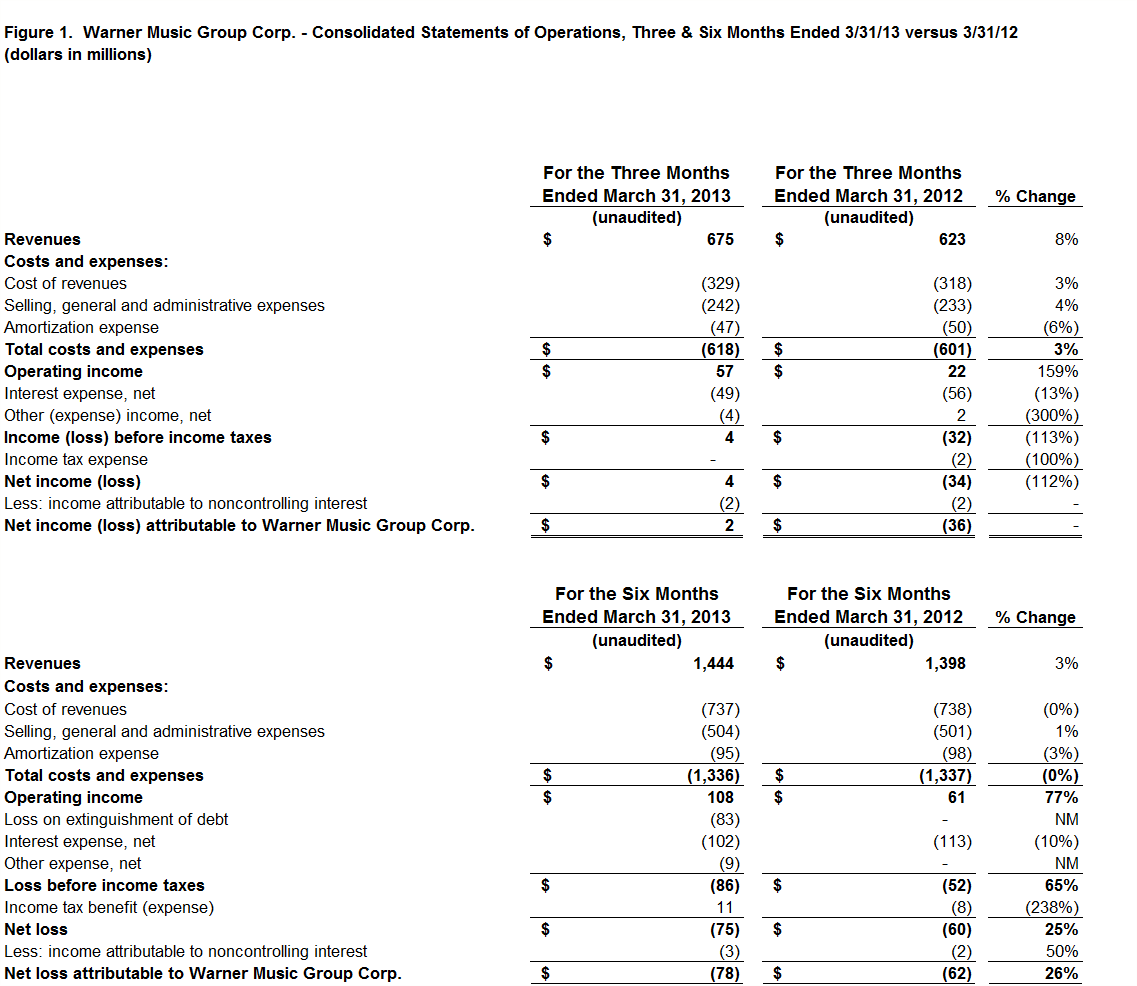
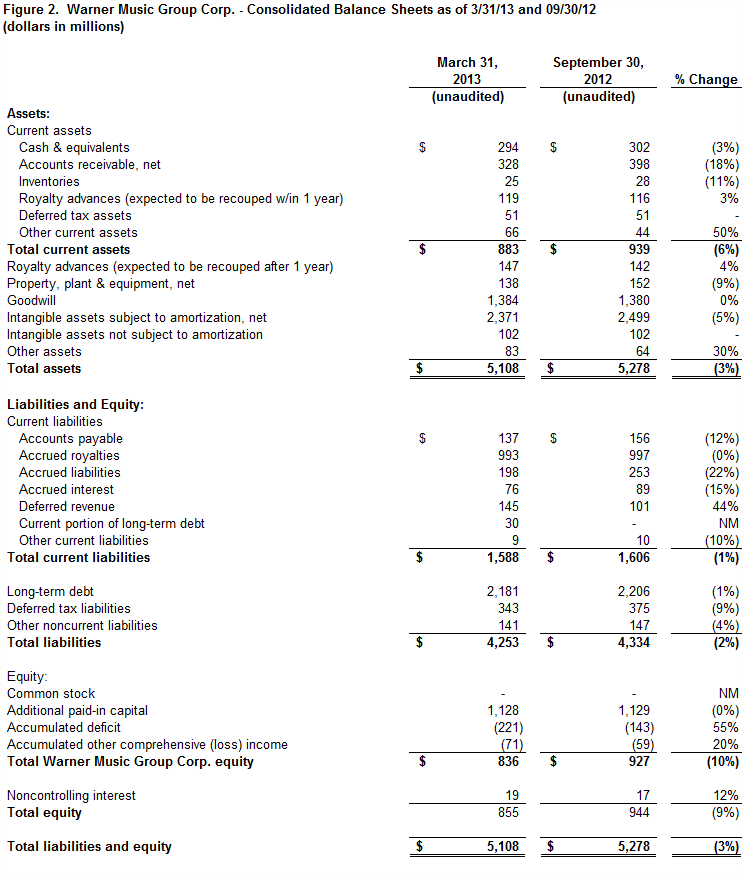

Supplemental Disclosures Regarding Non-GAAP Financial Measures
We evaluate our operating performance based on several factors, including the following non-GAAP financial measures:
OIBDA
OIBDA reflects our operating income before non-cash depreciation of tangible assets, non-cash amortization of intangible assets and non-cash impairment charges to reduce the carrying value of goodwill and intangible assets. We consider OIBDA to be an important indicator of the operational strengths and performance of our businesses, and believe the presentation of OIBDA helps improve the ability to understand our operating performance and evaluate our performance in comparison to comparable periods. However, a limitation of the use of OIBDA as a performance measure is that it does not reflect the periodic costs of certain capitalized tangible and intangible assets used in generating revenue in our businesses. Accordingly, OIBDA should be considered in addition to, not as a substitute for, operating income, net (loss) income and other measures of financial performance reported in accordance with GAAP. In addition, OIBDA, as we calculate it, may not be comparable to similarly titled measures employed by other companies. 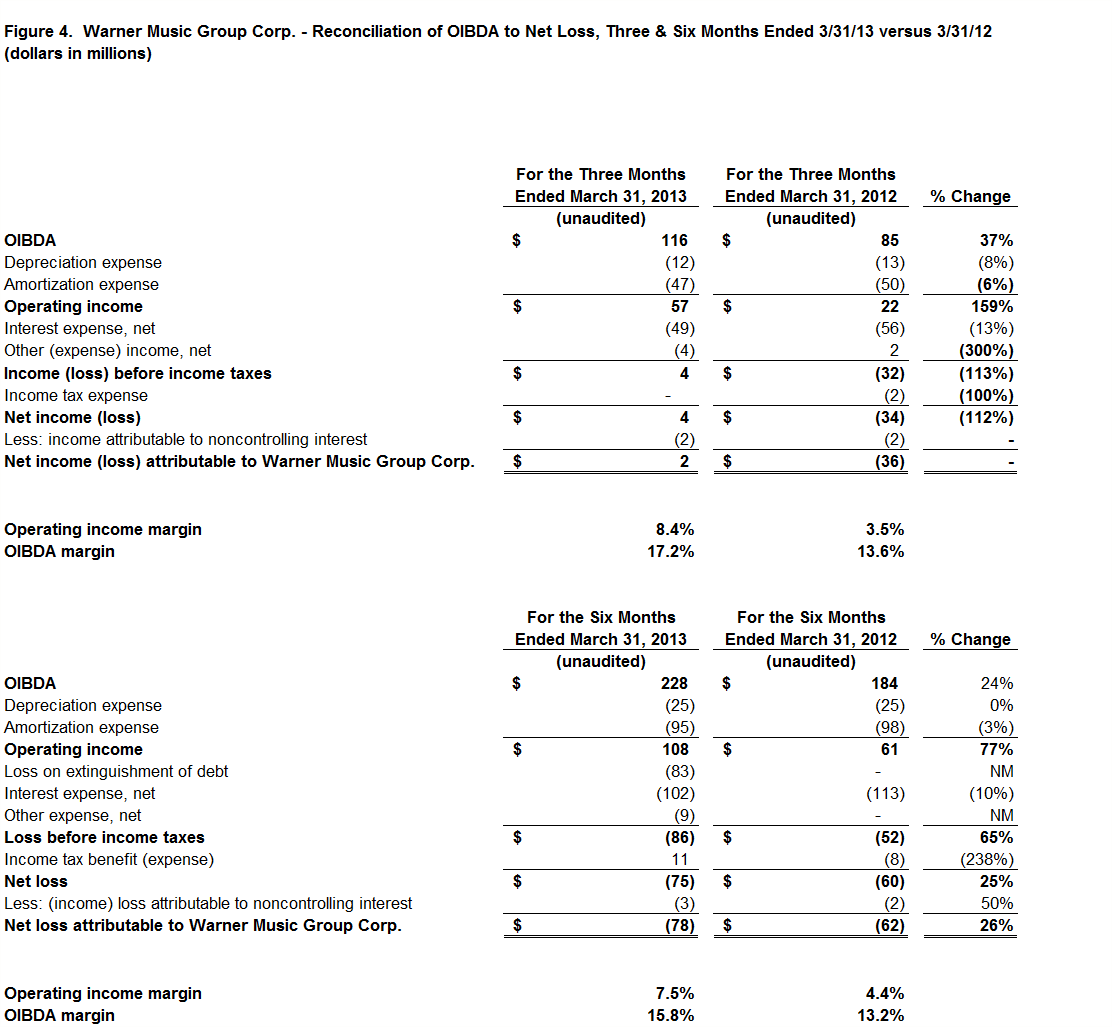
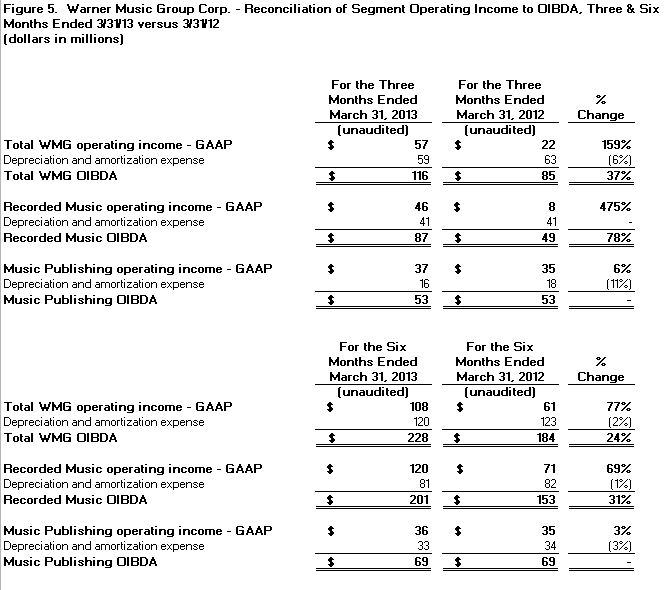
Constant Currency
Because exchange rates are an important factor in understanding period-to-period comparisons, we believe the presentation of revenue on a constant-currency basis in addition to reported revenue helps improve the ability to understand our operating results and evaluate our performance in comparison to prior periods. Constant-currency information compares results between periods as if exchange rates had remained constant period over period. We use results on a constant-currency basis as one measure to evaluate our performance. We calculate constant-currency results by applying current-year foreign currency exchange rates to prior-year results. However, a limitation of the use of the constant-currency results as a performance measure is that it does not reflect the impact of exchange rates on our revenue, including, for example, the $7 million, $6 million and $1 million unfavorable impact of exchange rates on our Total, Recorded Music and Music Publishing revenue, in the three months ended March 31, 2013 compared to the prior-year quarter. These results should be considered in addition to, not as a substitute for, results reported in accordance with GAAP. Results on a constant-currency basis, as we present them, may not be comparable to similarly titled measures used by other companies and are not a measure of performance presented in accordance with GAAP. 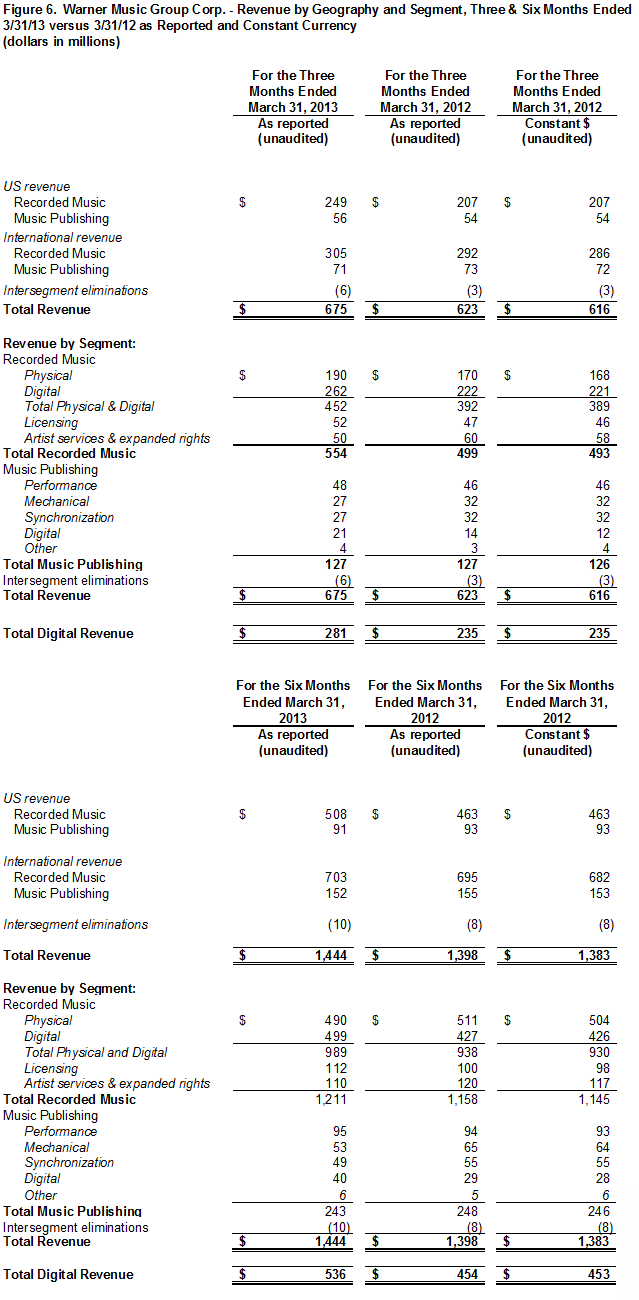
Free Cash Flow
Free Cash Flow reflects our cash flow provided by operating activities less capital expenditures and cash paid or received for investments. We use Free Cash Flow, among other measures, to evaluate our operating performance. Management believes Free Cash Flow provides investors with an important perspective on the cash available to service debt, fund ongoing operations and working capital needs, make strategic acquisitions and investments and pay any dividends or fund any repurchases of our outstanding notes or common stock in open market purchases, privately negotiated purchases or otherwise. As a result, Free Cash Flow is a significant measure of our ability to generate long-term value. It is useful for investors to know whether this ability is being enhanced or degraded as a result of our operating performance. We believe the presentation of Free Cash Flow is relevant and useful for investors because it allows investors to view performance in a manner similar to the method used by management. In addition, Free Cash Flow is also a primary measure used externally by our investors and analysts for purposes of valuation and comparing our operating performance to other companies in our industry.
Because Free Cash Flow is not a measure of performance calculated in accordance with GAAP, Free Cash Flow should not be considered in isolation of, or as a substitute for, net (loss) income as an indicator of operating performance or cash flow provided by operating activities as a measure of liquidity. Free Cash Flow, as we calculate it, may not be comparable to similarly titled measures employed by other companies. In addition, Free Cash Flow does not necessarily represent funds available for discretionary use and is not necessarily a measure of our ability to fund our cash needs. Because Free Cash Flow deducts capital expenditures and cash paid or received for investments from “cash flow provided by operating activities” (the most directly comparable GAAP financial measure), users of this information should consider the types of events and transactions that are not reflected. We provide below a reconciliation of Free Cash Flow to the most directly comparable amount reported under GAAP, which is “net cash flow (used in) provided by operating activities.”
Unlevered After-Tax Cash Flow
Free Cash Flow includes cash paid for interest. We also review our cash flow adjusted for cash paid for interest, a measure we call Unlevered After-Tax Cash Flow. Management believes this measure provides investors with an additional important perspective on our cash generation ability. We consider Unlevered After-Tax Cash Flow to be an important indicator of the performance of our businesses and believe the presentation is relevant and useful for investors because it allows investors to view performance in a manner similar to the method used by management. A limitation of the use of this measure is that it does not reflect the charges for cash interest and, therefore, does not necessarily represent funds available for discretionary use, and is not necessarily a measure of our ability to fund our cash needs. Accordingly, this measure should be considered in addition to, not as a substitute for, net cash flow provided by operating activities and other measures of liquidity reported in accordance with GAAP.
Source: Warner Music Group